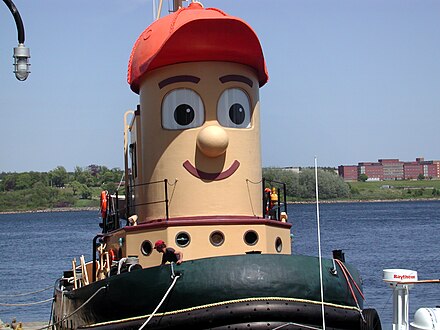Halifax Region
The Halifax Region, focused on Halifax, the capital of Nova Scotia, is the economic hub of the province and often the first point of entry. The city offers a diversity of things to do and places to go. The surrounding area has many recreation opportunities with beaches, parks and lakes.
Cities
- Halifax — the largest city in the Atlantic Provinces, and its economic and cultural hub; a busy Atlantic seaport
- Bedford — a suburban community that is home to Fort Sackville
- Cole Harbour — a suburban community in Dartmouth
- Dartmouth — the "City of Lakes"
- Hubbards — a picturesque locale with a yacht club, Nova Scotia's smallest provincial park, a campground and 10 beaches nearby
- Hubley — the Bluff Trail gives access to the Woodens River Watershed for hikers, paddlers, and winter sport enthusiasts
Other destinations
- Peggy's Cove — one of Canada's most picturesque villages
Understand
Halifax Regional Municipality occupies an area of almost 5,500 km² which is approximately 10% of the total land area of Nova Scotia, making it about the same size as the province of Prince Edward Island. It has a population of 403,000 people (2016), 43% of the total of the province of Nova Scotia.
The regional municipality consists of four former municipalities that were amalgamated in 1996: Halifax, Dartmouth, Bedford, and Halifax County.
Get in
By plane
- Halifax Robert L. Stanfield International Airport (IATA: YHZ), 44.886572°, -63.514937°. Provides connections to most of the major cities in Canada, and some international flights to the United States, the Caribbeans and London.
By car
Highway 102 (sometimes referred to as the Bicentennial Highway, or Bi-High) is the main road link, connecting with the Trans-Canada Highway 104 at Truro. The region is also the starting/ending point for the main roads through the Annapolis Valley (Hwy 101), South Shore (Hwy 103) and the Eastern Shore (Hwy 7). It is roughly a 3-hour drive from Moncton to Halifax and 3½ hours from Charlottetown to Halifax.
By bus
Maritime Bus provides service from Sydney, Truro, Amherst, Prince Edward Island, and New Brunswick.
By train
Via Rail provides service connecting Halifax to Montreal three times a week. The trip takes 22 hours and also stops at Truro and Amherst.
Get around
By car
There are two tolled bridges between Halifax and Dartmouth: Macdonald Bridge and MacKay Bridge. Cars with MACPASS pay $1.00 per trip and $1.25 if paid with cash. The cash lane only accepts quarters, $1 and $2 coins.
By bus
- Maritime Bus. Operates an inter-regional bus service stopping in Halifax, Dartmouth, Bedford and Lower Sackville.
- Halifax Transit. The public transit provider for Halifax and surrounding areas. 2019-07-25
By boat
A ferry service operates between Halifax and Dartmouth. It is a great boat ride, especially on clear summer days.
See
The lighthouse at Peggy's Cove is widely considered to be one of the iconic views of Canada. It is both bleak and picturesque: its historic and still-used lighthouse stands watch over the village and the granite rocks and cliffs.
The Halifax Citadel is an old fort on a hill overlooking the city and the harbour. The citadel is a National Historic Site and home to a museum and a small ceremonial garrison.
The collection of the Maritime Museum of the Atlantic in Halifax includes exhibits and artifacts related to the sinking of the RMS Titanic and the devastating 1917 Halifax explosion.
The Art Gallery of Nova Scotia in Halifax highlights the works of famous local artists such as Maud Lewis (folk) and Alex Colville (hyperrealist), in addition to Mik'maq (Indigenous) art.
Do

 The Royal Nova Scotia International Tattoo is held in Halifax every July. It is the world's largest annual indoor show. A combination of music, dance, drama, gymnastics, comedy, military displays, and competitions.
The Royal Nova Scotia International Tattoo is held in Halifax every July. It is the world's largest annual indoor show. A combination of music, dance, drama, gymnastics, comedy, military displays, and competitions.
The Tall Ships Festival takes place every few years. Halifax hosts up to 30 historic and unique (and usually massive) maritime sailing vessels from around the world. The next festival has not yet been scheduled.
The Bluff Trail in Hubley provides access to the Woodens River Watershed, a tract of provincial government land for hikers, paddlers, and winter sport enthusiasts.
Eat
- The Halifax donair is similar to but distinct from the doner kebab. It is prepared using thinly sliced beef meatloaf and a sweet condensed milk garlic sauce and garnished with diced tomatoes and white onions.
- Curly Portable's, Along Highway 2 in Enfield (turn off Highway 102 at Exit 7, turn east and drive for five minutes, it's on the left-hand side of the road), +1 902-883-8273. Real bar food in an old-fashioned tavern.
Drink
- Alexander Keith's has been brewing beer since 1863. Alexander Keith's India Pale Ale is sold across Canada. There are also many local craft breweries to choose from.
Stay safe
Go next
- Head south to historic Lunenburg.
Halifax Regional Council
Timezone:MultipleCoordinates:44.99, -62.91